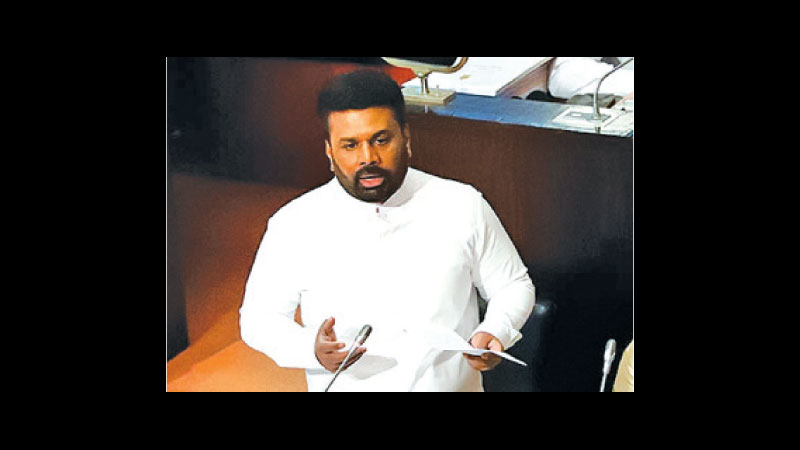 Sri Lanka’s 2025 Budget aims to drive economic recovery while adhering to the International Monetary Fund (IMF) commitments. However, several downside risks threaten its successful implementation under the new Government led by President Anura Kumara Dissanayake.
Sri Lanka’s 2025 Budget aims to drive economic recovery while adhering to the International Monetary Fund (IMF) commitments. However, several downside risks threaten its successful implementation under the new Government led by President Anura Kumara Dissanayake.
From lower-than-expected revenue collection to external shocks such as geopolitical tensions and global trade policies, these risks could derail the Government’s targets and economic stability. Such risks could lead to a repeated cycle of a bankruptcy, economists have warned. Navigating through all these downside risks is crucial to improve and maintain the stability of the country.
One of the most significant risks to the 2025 Budget is lower-than-expected revenue collection. Despite tax reforms and improved enforcement measures, weak domestic demand, tax evasion, and administrative inefficiencies may prevent the Government from meeting its revenue targets.
President Dissanayake in his Budget speech said, “The bulk of revenue gains is expected to be delivered by the liberalisation of motor vehicle imports that took place on February 1, 2025”. However, with the Government’s higher taxes, most buyers are going to delay their decision to impart a brand new vehicle. Vehicle importers say those who had been interested in importing a vehicle do not inquire about vehicles anymore. Though the Government imposed higher taxes as a deterrent to preserve foreign currency and prevent dollar outflows, the move is likely to reduce the target revenue from vehicle imports.
The country is in a recovery path, but it has not reached its potential economic growth. The island nation’s once vibrant small and medium enterprises are yet to come to their peak. This move could result in lower tax collections, widening the Budget deficit and increasing borrowing needs.
Extreme drought
Sri Lanka is highly dependent on agriculture and hydropower, making extreme weather events a critical downside risk. A severe drought in 2025 could lead to a decline in agricultural output, affecting food security and rural livelihoods. Sri Lanka could face below average rainfall from October 2025 if La Niña develops in the Southern Pacific Ocean, leading to a reduced Maha season rice crop in 2025, weather forecasters have already warned.
The country’s dependence on hydroelectricity means that a prolonged drought could lead to power shortages, increasing reliance on expensive thermal energy and pushing up costs for businesses and households. This would further strain Government finances and economic productivity.
The 2025 Budget assumptions rely on an optimistic growth target of five percent. However, if Sri Lanka fails to achieve this five percent GDP growth, it could impact revenue generation, employment, and investor confidence. Several factors, including slow global recovery, weak domestic demand, and structural bottlenecks, could contribute to subpar economic performance. Lower growth would make it harder to meet revenue targets, reduce the fiscal deficit and meet debt obligations.
Pace in reforms
The success of Sri Lanka’s economic recovery hinges on structural reforms, including State-Owned Enterprise (SOE) restructuring, trade liberalisation, and public sector efficiency improvements. The 2025 Budget hints of some policies towards SOE restructuring similar to Singapore’s Temasek model, something former President Ranil Wickremesinghe has been contemplating for a long time. This, along with some policies towards trade liberalisation, is positive for the country.
“Without reform and without good weather, it is stretched target,” former managing partner of PricewaterhouseCoopers Sujeewa Mudalige told a TV talk show after the Budget.
“Reforms are critical, otherwise we will be back again into the vicious cycle.”
The country also needs restructuring in its labour laws, recruitment of State employees, and educational reforms to boost foreign direct investments in the future. In reality, all the past Governments have spelt similar reforms in their Budget as well. But the implementation rate has been below 10 percent annually, analysts say.
Sri Lanka cannot afford slow reforms. It wants to start foreign loan repayments without another economic crisis. A slow or incomplete implementation of these reforms would deter Foreign Direct Investment (FDI) and reduce productivity gains. Delays in governance reforms could lead to loss of confidence among international creditors, complicating the country’s debt restructuring efforts.
Higher expenditure
The National People’s Power Government has given many hopes and expectations to all Sri Lankans. Implementing all of them in one or two years could lead Sri Lanka to another bankruptcy. President Dissanayake has signalled and vowed to prevent any such a repeated crisis. This means the Government has little space to spend on these welfare schemes people expect.
The Government has kept its commitment to the IMF bailout package – maintaining the primary expenditure at 13 percent of the GDP and a primary surplus of 2.3 percent.
However, though the Government aims to keep expenditures in check, there is a significant risk that spending will exceed Budgetary targets. Political pressures, social welfare needs, and unforeseen expenditures (such as natural disaster relief) could push Government spending beyond planned levels. This would widen the budget deficit, forcing the Government to borrow more and worsening debt sustainability concerns.
A failure to meet revenue targets could force the Government to cut public investments in infrastructure, education, and healthcare.
Reduced public investment would slow long-term economic growth and development, discouraging private sector participation and affecting job creation. Inadequate infrastructure spending, in particular, could undermine competitiveness and deter much-needed foreign investments.
Govt debt and interest rates
Sri Lanka’s debt burden remains a pressing concern, and any fiscal slippage in 2025 could lead to higher borrowing costs. If the Budget deficit widens due to lower revenue or higher expenditure, the Government may have to increase domestic and external borrowing.
Higher debt levels would lead to increased interest payments, reducing fiscal space for productive investments. Rising interest rates would also hurt businesses and consumers, slowing economic activity further.
Sri Lanka’s economy remains heavily reliant on tourism and remittance inflows. While both sectors have shown signs of recovery post-pandemic, external shocks such as global economic downturns, geopolitical instability, or policy changes in labour destination countries and Donald Trump-led United States could affect inflows. A decline in tourism earnings or worker remittances would put pressure on foreign exchange reserves, affect the balance of payments, and weaken the rupee, making imports more expensive.
Another downside risk is the inefficiency and limited capacity of Sri Lanka’s public sector. The Government has raised the public sector salary in a phased manner, though it has not been linked to any performance criteria. There is a desperate need for a public sector salary hike and lack of it would lead to more corruption. But the concerns about the efficiency of the public service have not been addressed through this salary hike.
Bureaucratic red tape, lack of skilled personnel, and corruption have historically hampered effective policy implementation. If these challenges persist, they could delay crucial infrastructure projects, reduce the effectiveness of fiscal measures, and undermine economic reforms. Public sector inefficiencies could also deter private investment, further slowing economic recovery.
Trump’s trade policy changes
The possibility of a shift in U.S. trade policies under Donald Trump’s leadership could pose risks to Sri Lanka’s export sector. The U.S. is Sri Lanka’s top exporter accounting for around $3 billion export revenue annually.
Potential tariff hikes, stricter trade regulations, or changes in U.S. trade agreements could impact Sri Lankan industries, particularly apparel exports. Any unfavourable policy changes could reduce export earnings and weaken the overall trade balance.
Sri Lanka is highly sensitive to energy prices. When energy prices are on the rise, it has a negative impact on the country’s growth. Fluctuating global energy prices pose a significant risk to Sri Lanka’s Budget.
Given the country’s reliance on imported fuel, rising oil and gas prices could increase import costs, widen the trade deficit, and drive inflation. Higher energy costs would also place additional strain on Government subsidies, potentially leading to fiscal slippage if fuel prices remain elevated for a prolonged period. Sri Lanka’s strategic location in the Indian Ocean makes it a focal point in the ongoing geopolitical competition between China and India. The growing rivalry between these two regional powers could create economic and diplomatic challenges for Sri Lanka. Pressure to align with either China or India could affect investment flows, trade agreements, and foreign policy decisions.
Heightened tensions could lead to disruptions in infrastructure projects, such as those funded by China’s Belt and Road Initiative (BRI) or India-backed development projects.









